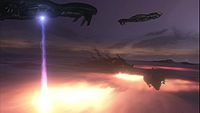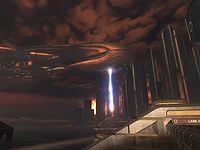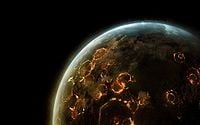Glassing
From Halopedia, the Halo wiki
- "You are... all of you... vermin. Cowering in the dirt thinking... what, I wonder? That you might escape the coming fire? No. Your world will burn until its surface is but glass!"
- — Prophet of Truth

The term Glassing, also known as Plasma Bombardment or Orbital Bombardment, is used to refer to the act by which a Covenant ship or ships bombard a planet from orbit using their Plasma Weaponry.
Significance
Glassing is a highly consequential process, as it is highly destructive, signifies an end to whatever was on there, and there is currently no known way to reverse it. Indeed, entire wars within the Covenant such as the Unggoy Rebellion and the Taming of the Hunters have been ended on a mere threat of glassing. Humanity was not given this option however, as they had been already decided by the Hierarchs to be completely obliterated.
Miltarily, glassing is a highly expensive process. Despite the Covenant’s xenocidal policy, typically glassing is used only to speed up a an invasion, while the ground troops and warships take care of the rest. For the complete annillation of a planet, a massive fleet of hundreds of ships is required, each with their own power, crew, and weapon requirements and the planet must also be guaranteed to be unneed for any economic, political, or religious, as the destruction of its surface gurantees that the planet is likely to never be used again.
Glassing is also a highly religious ritual for the Covenant, and as such a Prophet is required to be present when complete obliteration is called[1]. After all the planetary defenses and points of interest have been taken care of and as the ground troops are being evacuated, the crew of the presiding flagship gathers as the Shipmaster and Prophet recite the Writ of Union, while interweaving tales of the current fleet’s miltary triumphs within the recital. The purpose of the ceremony is for the Prophet to determine if the Shipmaster and his crew are truly worthy to carry out this task.
After the Shipmaster states the final line: “Speak, my Prophet, and let the word destroy all those who stand in the way of the Great Journey.”, the Prophet will then tell them the glyph which will mark the first area of impact. The Shipmaster himself must then launch the first shot, and makein the process sure that the crater left from the impact perfectly matches the glyph called for by the Prophet. He must then fall to his knees and wait for the Prophet declare his success and thus fit for the Great Journey, or failure and thus worthy of death.
If he succeeds then the glassing process by the rest of the ships under his command will now proceed. The Prophet aboard will also be bound to his crew as their master and the crew will now serve as his representatives.
Methods
The Covenant have been known to utilize two methods of glassing. The first and the most common method used is when a ship or ships build up plasma along their lateral lines and discharge lances of plasma from orbit, which are guided until they impact the surface. This is repeated until every square centimeter of the planet is destroyed; in most cases it only takes the Covenant twelve hours to glass a planet.
Orbital Glassing

The Covenant will begin glassing a planet by bringing in a fleet of ships and typically move their large warships closer and blanket the world with a series of crisscrossing orbits to ensure that every square millimeter of the surface is destroyed. The large warships will aim their weaponry towards the surface and begin to build up energy. The superheated plasma "bolts" are then released and guided towards the surface, a difficult process as the plasma must maintain a magnetic envelope all while falling through miles of atmosphere and still retain a stationary trajectory.
Low-range glassing
The second method is used when a ship must effectively destroy a ground target from low range. This method involves building up plasma from the underside of the ship and then discharging it in a narrow, concentrated beam; This method of glassing is likely the most common version, and used to speed up the process of a ground invasion. Unlike orbital glassing, this method covers a much smaller area and has no religious signifance; as such, the process is typically handled by the ship’s automated procedures. This method of low-range glassing has only been witnessed a few times, most notably during the Battle of Pegasi Delta[2], the glassing of New Mombasa and Voi during the Battle of Earth.
Digging
Glassing has also been used in the Covenant’s search for Forerunner artifacts. Most of the time, if an artifact is detected on a Human planet, the area is ignored during the bombardment so that it will not be damaged. If it is underground, however, glassing can be used to burn through the ground and undercover it. This is typically done in-atmosphere and at low range, for a precise dealing.
Since most glassing procedures tend to harden the surface, rather than crush it, it is speculated some unknown mechanism may be used within the ships’ Energy Projectors. Indeed, the Prophet of Truth himself apologizes to the Forerunners during the 2nd Battle of Earth for risking descration of the relic with their bombardment with plasma[3], though then tells his troops their speedy digging of it will bringthem greater honor and atone the error.
Effects
The impact of the plasma bolt is similar to that of a nuclear detonation on a much different scale. When the plasma bolt impacts the surface, the magnetic field sustaining and guiding the plasma collapses, and, depending on how powerful the release of energy is, the initial zone of impact is obliterated instantly. The areas outside of the initial impact zone are affected by the heat wave generated by the blast; depending on the range, those closest outside of the blast zone are instantly killed by the intense heat.
As thermal expansion takes over, the resulting flames fan out and create a pyroclastic surge,[4] which will continue to burn the areas it comes into contact with until it has cooled enough that it cannot harm the surface. Subsequently, the atmosphere is covered with soot and ash thrown up from the initial impact, subjecting the planet to a nuclear winter. The atmosphere of most planets have been known to boil away from the process[5], though not all planets suffered this, the most notable examples being Reach and Harvest.
The ecosystem of a planet is also disposed of through this process. The superheated plasma "bolts", when striking the area, cook the top soil and other surface geology so that it is converted into a mineral called lechatelierite, a type of silicon dioxide that resembles glass[6], hence the name “glassing.” The process also vaporizes any bodies of water the planet may possess, or at least reduces the remaining water to pools choked with ash [7].
As the initial impact area cools, the surface is covered by extensive areas of molten soil, and is comparable to active volcanic sites in some parts of the world, on a larger scale depending on the extent. The destructive process leaves the planet unable to recover to its former state.
Use

Throughout the Human-Covenant War, the Covenant aggressors glassed a significant majority of the UNSC's colony worlds from orbit. And although ground forces were invariably deployed first, as UNSC forces were routed in space, the bombardment would commence.[8] The first planet to suffer this fate was Harvest, glassed from the Jiralhanae-operated cruiser Rapid Conversion.[9] It has been noted that areas of interest to the Covenant are left intact for reasons of study or retrieval; however, this is not common, as only three planets have been partially glassed and only when a Forerunner Artifact was discovered.[10] After the Covenant glasses a planet, a shard of glass is removed and placed in the Step of Silence within High Charity, where it hangs with hundreds of other shards from worlds glassed by the Covenant.[11]
The Battle of Earth culminated in the glassing of the city of Voi in Africa by Covenant Separatists, in an effort to contain a Flood infestation which had come to Earth only hours earlier. [12] Lord Hood accuses the Sangheili lead fleet of glassing half of the continent, but given his distaste for his former enemies, he might have exaggerated about the actual extent of the glassing. This is supported by the fact that the area around Kilimanjaro seems relatively intact during the ceremony at the end of the game. It is currently unknown exactly what other areas of Earth was glassed by the Covenant prior to, and during the events of Halo 3.
Halo Wars
In Halo Wars, the Prophet of Regret faction of the Covenant are able to use the Prophet to call down a Cleansing Beam from an orbiting Covenant ship. Rather than a leader power, this is treated as the unit's secondary ability, using the Y button to guide the beam at the cost of resources every second. It lacks the power of typical glassing maneuvers seen in past canon to balance gameplay. However, the power may be lowered to avoid Covenant casualties.
Trivia
- By the end of Halo: First Strike and Halo 2, it is believed that the Covenant had glassed 76 planets which were represented by 19 shards in 4 rows in the Step of Silence.[13][14]
- It has been noted that the UNSC had over 800 planets colonized or under its control at the beginning of the Human-Covenant War, a large portion of which presumably fell to the Covenant during the war. However, the Step of Silence, an area where a piece of glass from every glassed planet is placed, only has 76 shards of glass. This is explained however, in Halo: Evolutions. It states that the majority of the time, the Covenant only glass major population centers and military bases on conquered planets, so it is likely that shards of glass are only taken from fully glassed planets.
Sources
- ^ Halo: Evolutions - Essential Tales of the Halo Universe The Return, pg.495
- ^ Halo:Ghosts of Onyx Prologue, page 25
- ^ Halo 3, Tsavo Highway (Level)
- ^ Wikipedia's article on Pyroclastic Surge
- ^ Halo: The Fall of Reach, page 8
- ^ Wikipedia's article on Lechatelierite
- ^ Halowars.com
- ^ Halo: The Fall of Reach
- ^ Halo: Contact Harvest
- ^ Halo: First Strike
- ^ Halo: First Strike Epilogue, page 338
- ^ Halo 3, Floodgate (Level)
- ^ Halo: First Strike, page 338
- ^ Halo 2: High Charity


